11 Plant Eating Bugs In The Garden: Pictures, Identification and Control
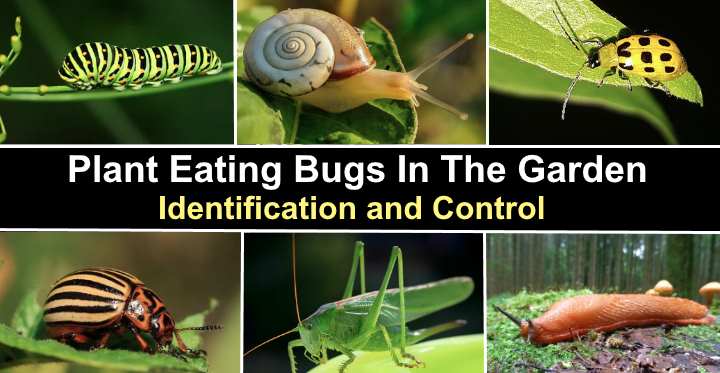
Plant-eating bugs can cause havoc in your garden. Many species of bugs and pesky insects create holes in the leaves and flowers of ornamental shrubs, annuals, and vegetable crops. Nasty critters like plant-destroying caterpillars, slugs, snails, aphids, and some beetle species can skeletonize plant leaves, making them look like shabby lace.
Knowing how to stop bugs from eating your plants is crucial information for any gardener. However, it’s also crucial to identify insects that eat plants to control them. This way, you can learn about the bugs’ habitat and behavior patterns to ensure that bugs in the garden don’t become an uncontrollable nuisance.
One of the problems with identifying plant-eating bugs is that the holes seem to appear out of nowhere. Some pests that eat plant leaves only feed at night when their destructive behavior goes unnoticed. Other insect species, like many caterpillars, have excellent camouflage, making them difficult to spot and eradicate.
Of course, identifying plant-eating bugs in the garden is crucial to rule out the possibility of fungal or bacterial foliar diseases.
This article helps identify 11 common bugs and insects that eat garden plants. In addition to pictures of plant-munching bugs, you will get helpful tips on eradicating these pests from your garden.
Plant Eating Bugs vs. Insects
Most people refer to all types of pests that eat plants as bugs. But not all plant-eating insects are bugs in the scientific sense. True bugs are insects in the order Hemiptera. These pests have piercing mouthparts they use to suck plant juice. However, not all plant-eating insects destroy vegetation by sucking sap.
Types of true bugs in the order Hemiptera that eat plants include aphids, stink bugs, mealybugs, and scale insects. Plant-destroying insects that are not classified as true bugs include beetles, slugs, snails, caterpillars and earwigs.
However, it’s common to refer to any type of creepy crawly that damages plants as a bug. In addition, some dictionaries loosely define a bug as “any insect or insect-like invertebrate.” Therefore, this article refers to all insects that cause plant damage in gardens as bugs.
Plant Eating Bugs In The Garden — Pictures, Identification and Control
Many types of bugs eat plants, and you can find them crawling on plants in your garden. These insects damage plants by chewing holes in leaves, nibbling on flowers or sucking the life from vegetation. Let’s look in detail at 11 types of bugs you never want to see in your garden.
Slugs Eat Plant Leaves
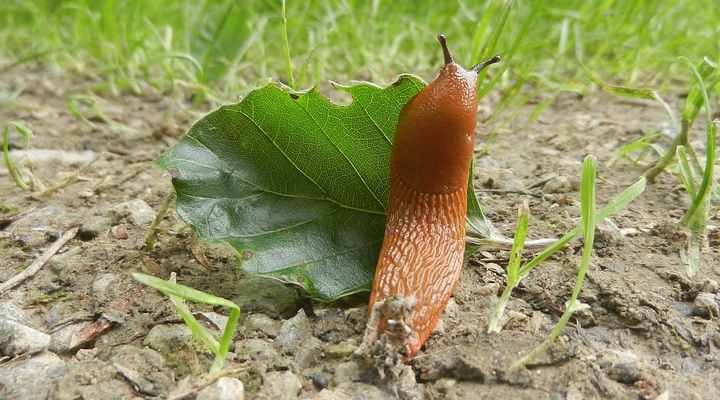
The soft-bodied slugs are garden pests that eat plants
Slugs are one of the worst bugs in the garden when it comes to eating plant leaves. Slugs are agricultural pests characterized by their soft body and slimy appearance. Identification features of slugs include their soft tentacles, ribbed appearance, and slime trail. Slugs often come out after the rain and hide in dark, damp places during drier weather.
Depending on the species, slugs can be long and slender with a tapering tail end. Or they can be stout, relatively fat gastropods. Garden slugs can measure between 0.25” (6 mm) to 2” (50 mm). Most slugs that eat plants are brownish or gray, but some can be jet-black.
Slugs are most active during spring and through late summer. Slugs eat leaves from many different types of vegetation, including seeds, fruit, and vegetable matter. Excessive feeding can lead to weakened plants.
Plant bug identification
Slugs are soft-bodied slimy creatures that are easy to identify. Slugs have distinguishing features like two tentacles, a mouth, and a breathing pore on their side. Additionally, they have a smooth underside (sole). You can tell there are slugs in your garden due to slime trails on driveways and paths.
Signs of slug damage
When slugs eat plants, they chew holes in leaves and flowers, leaving them with ragged edges. The chewed plant leaves have scalloped edges, and large slugs can devour entire leaves. Slugs also attack bulbous and tuberous plants. The voracious bugs munch holes in root and plant bulbs.
How to control plant-eating bugs
An effective way to kill slugs without chemicals is to use beer traps. To make a slug trap, fill a small metal or plastic bowl with beer and place traps at several strategic locations in your garden. The yeast from the beer attracts slugs, and they will climb in and drown inside the bowl.
Do beer traps for slugs work? A study published in the journal Crop Protection found that beer traps for slugs were just as effective as commercial slug traps.
Find out about other natural methods to eliminate slugs from your garden.
Caterpillars Destroy Plant Leaves
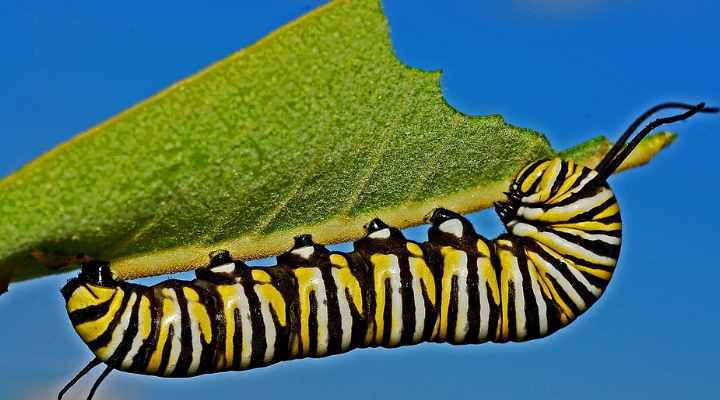
A picture of a monarch caterpillar eating a leaf
Caterpillars are a type of worm-like insect with insatiable appetites for plant leaves. Species of caterpillars are easy to identify compared to other plant-eating insects due to their soft cylindrical bodies. The creepy crawlies can be hairy, smooth, or covered in poison-filled spines. Caterpillars also come in a range of colors.
To identify caterpillars, note their size, color, specific markings such as striped or spotted, and if they are hairy insects. For example, stinging caterpillars are typically identified by their bodies covered in spines or fine setae. Other types of slug-like insects are horned caterpillars with distinctive fleshy horn-like spikes at either end.
Types of caterpillars that eat plants include tomato hornworms, inchworms, cutworms, cabbage worms, and bagworms.
Plant bug identification
To identify a caterpillar species, look for its distinctive features. Identifying marks of caterpillars are head horns, spines, a curled or split tail, or just a rounded head and tail end. Next, look at the size of the caterpillar. Some plant-eating species are huge green bugs with large heads.
Signs of caterpillar leaf damage
The typical signs of caterpillar damage are chewed leaf edges, holes in leaves, or entire leaves missing from plants. You may also notice silky strands of web-like structures on plants. Caterpillars are voracious plant eaters that can quickly defoliate entire plants.
How to control plant-eating bugs
The best way to get rid of plant-eating caterpillars is to handpick them from plants and drop them into soapy water to kill them. Another way to stop caterpillars from eating plants is to introduce beneficial insects that feed on eggs and immature caterpillars, such as lacewings or parasitic wasps.
Snails Eat Plant Leaves
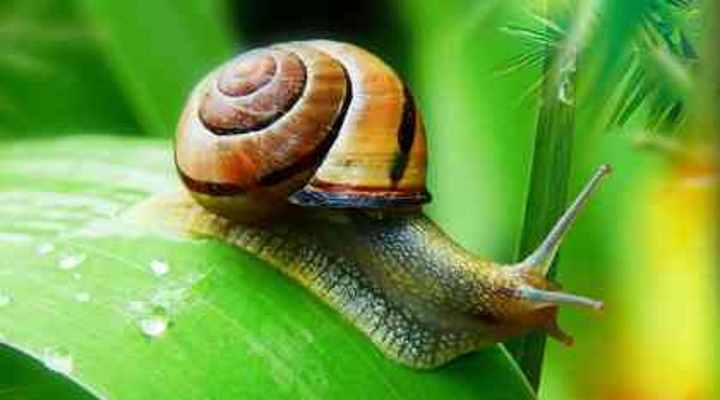
Snails are not insects or true bugs but are plant eating gastropods that can cause a serious damage in the garden
Snails are small, soft-bodied gastropods that eat plant leaves, roots, flowers, and stems. Although slow-moving, snails can cause severe damage to plants by using their tiny mouths to chew through plant material. The slug-like shelled creatures will feed on tender, leafy foliage. Like slugs, snails leave a trail of mucus and slime.
Garden snails are described as one of the most destructive pests. Almost no type of plant foliage is safe from snails’ feeding habits. They destroy turfgrass seedlings, herbaceous plants, ripening fruits, tubers, and bulbous plants. However, they avoid plants with strong-smelling leaves or hairy, waxy, or glossy foliage.
Plant bug identification
Snails are easily identified by their coiled shells on fat, slimy worm-like creatures. Snails have two tentacles, a mouth containing thousands of teeth for eating plants, and a mucus-producing underside.
Signs of snail leaf damage
Classic signs of snail damage are large, ragged holes in leaves and slime trails across chewed leaves. The destructive slimy bugs can devour entire leaves and destroy seedlings.
How to control plant-eating bugs
How can you get snails to stop eating your plants? Like killing slugs, beer traps are an excellent control method for snails. Additionally, like caterpillars, you could handpick snails from plants and drop them into soapy water to kill them.
Japanese Beetles (Popillia japonica)
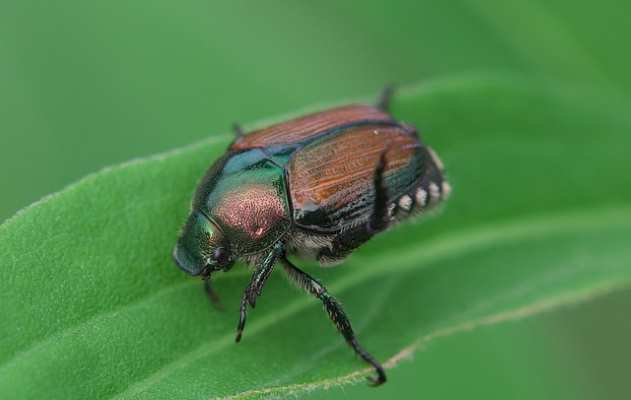
Skeletonized leaves are the most common sight of Japanese beetle plant damage
Japanese beetles are a type of scarab beetle that destroy plant foliage by eating leaves. The beetles are identified by their brightly-colored metallic green and bronze or golden-copper bodies. Japanese beetles measure 0.6” (15 mm) long and 0.4” (10 mm) wide. You will also notice five recognizable white tufts along the beetle’s midsection.
Japanese beetles eat the leaves of plants on roses, various types of deciduous trees, azaleas, plant foliage in the pea family, and hibiscus shrubs.
Plant bug identification
Japanese beetles are identified by their hard wing covers that are iridescent green and coppery-bronze colors.
Signs of Japanese beetle leaf damage
Japanese beetle plant damage typically looks like skeletonized leaves. This is because the small bronze and green bugs only eat between leaf veins, resulting in leaves that look like lace.
Japanese beetle grubs live in the soil under turf grass and shrubs. The fat, white c-shaped bugs feed on roots. Typically, damage from the grubs looks like withered foliage or patches of brown grass.
How to control plant-eating bugs
Inspect plants in mid-summer for signs of bug activity to eliminate Japanese beetles. Then handpick the critters and drop them into a bucket of hot, soapy water. You can also find out about more ways to eradicate Japanese beetles.
Cucumber Beetles
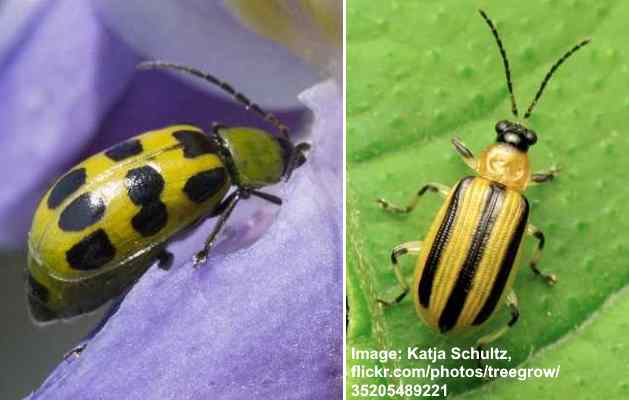
Spotted cucumber beetle – Diabrotica undecimpunctata (left) and striped cucumber beetle – Acalymma vittatum (right)
Cucumber beetles are small yellow beetles with black spots or stripes. These yellow beetles eat plant leaves, shoots, and flowers of crops in the cucurbit family — cucumbers, squash, pumpkins, zucchini, and watermelons. The yellow beetles have a black head, two antennae, and six legs.
Plant bug identification
Cucumber beetles are easy to identify due to their vibrant yellow elytra (wing covers), yellow abdomens, and small size. The spotted cucumber beetles have 12 black spots on a bright yellow back and greenish thorax. The striped cucumber beetle has three black bands along its yellow back and a yellow thorax.
Signs of cucumber beetle leaf damage
Leaves with large, ragged holes are the most common sign of adult cucumber beetle damage. However, the yellow bugs also damage small plants and transmit foliar diseases that cause bacterial wilt.
How to control plant-eating bugs
Use a homemade neem oil spray to kill immature beetles in spring. To make a neem oil bug spray, mix 2 tsp. neem oil, 1 tsp. liquid Castile soap and 1 quart (1 l) of water in a spray bottle. Shake the mixture well. To treat plants, spray the neem solution on foliage in the evening. Repeat every once a week to eradicate the plant-eating beetles.
You can also find out about more ways to control cucumber beetles.
Aphids

Aphids on plants look like tiny crawling insects with various colors depending on the species, with some developing waxy or wooly coating
Aphids are highly destructive bugs that suck the juice from garden plants. The tiny damage-causing pests lurk under foliage where they do damage. Aphid infestations cause stunted plant growth, wilted foliage, and leaf drop. In severe cases, aphids can end up killing the various types of front or backyard plants.
Aphids have pear-shaped bodies and measure less than 0.23” (6 mm). However, some species can be as small as 0.07” (2 mm). Aphids typically feed in large groups, meaning that noticing a large infestation is not difficult. Depending on their color, aphids can be called greenfly, whitefly, or blackfly.
Plant bug identification
Aphids are identified as tiny tear-shaped bugs with long legs and two protruding tail-like structures at their tail end. Some aphids have a white fuzzy coating and are known as woolly aphids.
Signs of aphid leaf damage
Damage caused by aphids feeding on plants results in stunted growth, yellow, crinkled leaves, and curling leaves. In addition, aphids leave behind honeydew — a yellow sticky substance on plants. Also, black sooty mold may be visible on plant leaves is another sign of aphid plant damage.
How to control plant-eating bugs
The easiest way to eliminate plant-destroying aphids from your garden plants is to use the hose. Spray a strong jet of water with enough pressure to displace the nasty critters without harming foliage. Ensure you thoroughly douse both sides of the plant leaves.
Colorado Potato Beetle
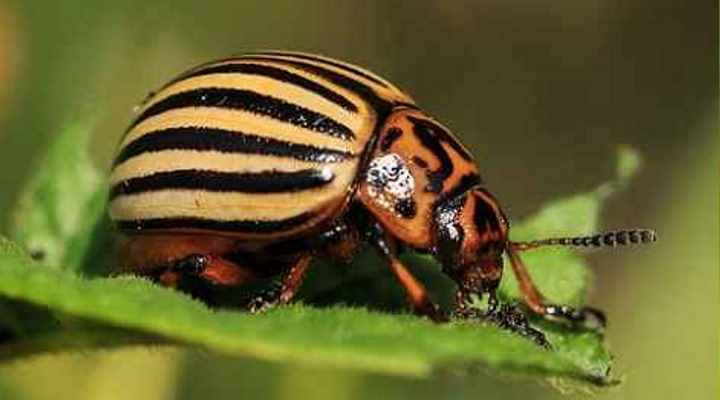
The Colorado potato beetle (Leptinotarsa decemlineata) doesn’t feed only on potato crops, but also feeds on other plants in the nightshade family
The Colorado potato beetle is a striped beetle that eats potato plant leaves. This striped beetle has orange and black lines along its back. In addition, the small, destructive bug-like pest has an orange and black thorax, clubbed antennae, and orange legs.
A distinctive feature of this beetle that eats plants is its rounded body with distinctive stripes. The nasty beetle measures 0.24” to 0.43” (6 – 11 mm) long. You will often find it destroying the leaves of plants in the nightshade family, most commonly potatoes.
Plant bug identification
The Colorado potato beetle is a small leaf beetle with easily recognizable pale black and orange-beige stripes, black markings on a flattened orange head, and two segmented antennae.
Signs of Colorado potato beetle leaf damage
Leaf defoliation is the most common sign of a Colorado potato beetle infestation. You may also notice ragged edges on leaves and dark frass on foliage. The adult yellow or orange and black striped beetles feed on the leaves and stems of potato crops.
How to control plant-eating bugs
The best way to control Colorado potato beetles is to handpick the nasty critters from plants. Also, look for and destroy yellowish-orange eggs on the underside of foliage.
Grasshoppers

Grasshopper are plant eating bugs that are usually green or brown and vary in size, depending on the species
Grasshoppers are destructive plant-feeding insects that rapidly destroy vegetation. Grasshoppers can be green or brown insects with large hind legs, a face angled vertically to their body, and two stumpy antennae. Species of grasshoppers range in size from a few millimeters long to huge leaf-feeding insects over 3” (75 mm) long.
Plant bug identification
Grasshoppers are readily identifiable bugs that feed on plants. The slender insects typically have a green or brown body, and some are multicolored or have mottled patterns.
Signs of grasshopper leaf damage
Typical signs of damage that grasshoppers cause when eating plants include large holes, ragged holes with bite marks, and defoliated vegetation – especially in the case of locusts.
How to control plant-eating bugs
According to Colorado State University, grasshopper infestations are difficult to control. The best control method is to prevent the eggs from hatching. For example, it’s a good idea to till the soil in late fall and early spring to kill any eggs in the ground. Other ways can be found in the article on how to get rid of grasshoppers in the garden.
Squash Bugs
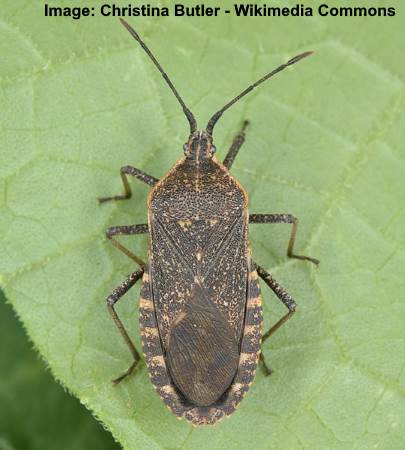
Squash bugs (Anasa tristis) damage mainly pumpkin and squash plants by sucking the sap from the leaves
Squash bugs are insects that feed on plants by sucking the sap from leaves. A brown-colored squash bug has a recognizable flat back and a brown body with tan-colored speckles that measure around 0.6” (15 mm) long. A characteristic of squash bugs is the foul stench they emit when crushed.
Squash bugs do considerable damage to plants. The shield-shaped brown bugs cause plant leaves to wilt and die. They also go by the name of stink bugs because of the foul odor they release when you squish them. However, their common name comes from the fact that they infest squash plants.
Plant bug identification
Squash bug identification is by its dark gray or brown flat back, elongated oval body spotted back, and triangular markings.
Signs of squash bug leaf damage
Squash bug causes damage to plants, seen as yellow spots on squash and pumpkin leaves. Severe infestations cause leaves to turn yellow, wilt, and die.
How to control plant-eating bugs
The best natural method for squash bug extermination is picking the adults and nymphs from leaves and dropping them in a soapy water bucket. If there is a cluster of bugs on a squash plant leaf, removing the entire leaf and killing it in soapy water is a good idea.
Related reading: How to get rid of squash bugs without pesticides.
Mexican Bean Beetle
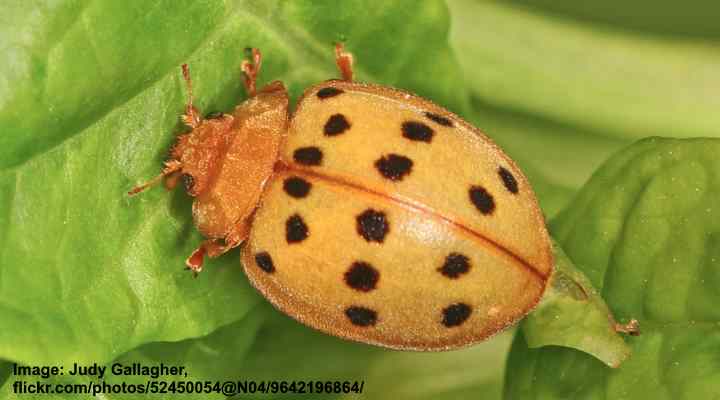
The small orange Mexican bean beetle (Epilachna varivestis) is covered in black spots and feeds on bean plants
The Mexican bean beetle eats plant foliage, leaving blades skeletonized. The tiny orange beetles are identified by their rounded, oval wing covers covered in jet-black spots. This orange, black-spotted beetle has an orange head, thorax, and two clubbed black antennae. This beetle is a type of ladybug measuring 0.23” to 0.27” (6 – 7 mm).
The Mexican bean beetle is often found feeding on flowers and seed pods of plants in the pea family Fabaceae. The plant-eating beetles cause damage to plants by destroying leaves and making them look like wilted lace. This beetle can be orange, yellow, or red.
Plant bug identification
The Mexican bean beetle has a characteristic round shape and a bright orange back covered in black spots.
Signs of Mexican bean beetle leaf damage
Mexican bean beetle damage occurs when the tiny orange and black beetles eat plant tissue between leaf veins. This results in leaves with a transparent appearance that are skeletonized. Adult beetles may also destroy flowers, bean pods, and stems.
How to control plant-eating bugs
The best way to stop Mexican bean beetles from eating plants is to destroy the egg clusters and larvae by hand. However, if infestations are severe, you can use Spinosad as a natural pesticide.
Tarnished Plant Bug
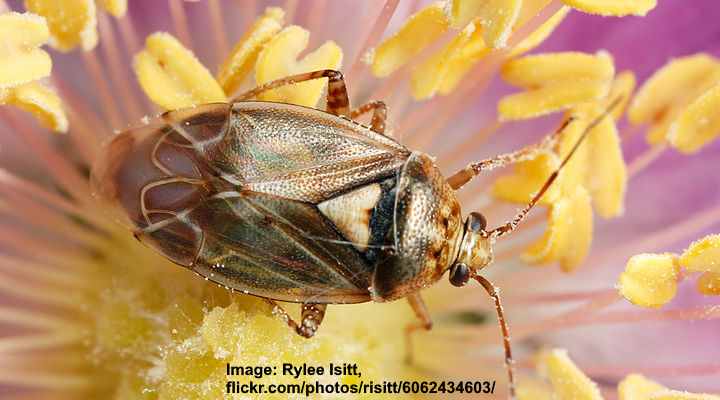
Tarnished plant bug (Lygus lineolaris) is a plant eating insect that damages flower buds
The tarnished plant bug is a brownish plant-feeding insect that attacks the bud of developing fruits. These bugs have a pear-shaped brown body with dark and pale brown markings, brown-banded legs, and antennae. The critters damage plants by inserting saliva through their sucking mouthparts. These bugs affect many bean plants, crops, and ornamental shrubs.
Plant bug identification
The tarnished plant bug is identified by its brown body and brown legs.
Signs of tarnished plant bug leaf damage
Signs of leaf damage caused by tarnished plant bugs include damaged flower buds that drop early, blooms that fail to open, deformed leaves, as well as scarred and discolored leaf petioles or stems.
How to control plant-eating bugs
If you suspect tarnished leaf bugs are feeding on plants in your garden, take the garden hose to the plants. A short, sharp blast of water is usually enough to remove the tiny creepy crawlies from plant foliage.
Related articles:
